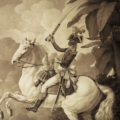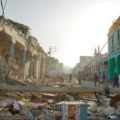Inventing a Nation: Jacques Roumain and Haitian Kreyòl

Haitian independence from France in 1804 led to a host of consequences for the first black republic in the world. Among them was a fraught relationship with the new nation’s lingua franca, Haitian Kreyòl, derived from eighteenth-century French and inflected with Portuguese, Spanish, Taíno, and an untold number of West African languages. The ruling class, educated in France, and the bourgeoisie both have traditionally preferred French as the official language of both the state, Haitian literature, and the public education system. Kreyòl, spoken by the Haitian “masses,” did not become a national language until the 1987 constitution and is still subject to variations in spelling. Despite efforts to standardize Kreyòl and assert its legitimacy in recent years, many Haitians still believe Kreyòl incapable of expressing intellectual complexity or of matching the literary range of French. Though widely spoken and foundational in Haitian culture, Kreyòl remains linked to class consciousness as the province of peasants and common people.
This is only part of what makes Haitian author Jacques Roumain’s work so remarkable. Born on June 4, 1907, to an elite, land-owning family, Roumain enjoyed an enviable education in Port-au-Prince and Switzerland. As the eldest of eleven children, and the first son, he was expected to take charge of the family’s sugar cane operation on his return from four years in Europe in 1926. But the American occupation of Haiti (1915–1934) determined his path and defined his destiny as a major voice of the “occupation generation.” Rather than bend to familial expectations in the late 1920s, he cofounded literary journals and youth organizations. His uncompromising voice led to arrests and detention for minor offenses, and his Marxist political view to charges of conspiracy against the Haitian government. The latter resulted in a three-year prison sentence late in 1934. Years of exile followed his release, during which he was plagued by financial uncertainty, illness, personal isolation, and poverty before he was allowed to return to Haiti in 1941.
For many, Roumain’s legacy rests on the novel found in his briefcase when he died unexpectedly at age thirty-seven. Since then, Gouverneurs de la rosée has become etched in Haitian consciousness and translated into nearly twenty languages, most famously perhaps by Langston Hughes, as Masters of the Dew (1947), and most recently into Haitian Kreyòl by Clotaire Saint-Natus as Mèt Lawouze Douvanjou (2007). There is, however, another novel by Jacques Roumain that deserves attention—a first novel, whose startling innovations include the use of Kreyòl.
By the time La Montagne ensorcélée was serialized in the Haïti-Journal in the winter of 1931, Roumain was already well-known as an outspoken and astute observer of Haitian society. At only twenty-four years old, he had written brilliant polemics on Haitian politics, a series of articles on Mahatma Gandhi, a chatty column signed “Ibrahim,” and two collections of urban fiction. And yet this novel came as a shock for its merciless exposé of social injustice and murderous mob psychology in the Haitian hills. As the first peasant novel (roman indigène) in Haitian literature, La Montagne appeared in an era when many in Haitian society were eager to claim an authentic “Haitian soul” in the midst of a humiliating occupation. The book expressed the depth of that soul as it unmasked a racist, classist social order.
Frantz-Antoine Leconte, co-editor and translator with Alfonso J. García Osuna of the only English edition of La Montagne ensorcélée to date (The Bewitched Mountain, 2007), explains in his introduction: “Haitian literature was like an immense ghetto inhabited by men and women without rights and without hope, a literary space whose legitimacy seemed to be validated by its chronicling of people’s miraculous survival in a world programmed against them ….” Taking note of the novel’s subtitle, “récit paysan” (an account of peasant life), Caribbean scholar Marie-José N’zengou-Tayo writes, “Roumain invites us to read La Montagne ensorcélée as a witnessing of the conditions of life in the Haitian countryside.”
Roumain makes this possible, in part, through his innovative use of Haitian Kreyòl, with all its sociopolitical importance. And because this artful debut novel relied heavily on language to claim a new terrain for Haitian literature, it also raises critical questions for translators: How does one “translate” utterly foreign realities in order to create a novel of witness? What aspects of foreign, indigenous language should be retained, or explained? What sensitivities and political implications arise when a privileged, literate intellectual sets out to bring a community of illiterate, helpless people to life? Ultimately, what level of cultural translation allows characters to achieve “an enduring presence” in a foreign language?
Roumain’s use of two languages—French and Kreyòl—actually involves three variations: standard French, “Kreyòlized” French, and Haitian Kreyòl. The first is encountered in the omniscient narrator, who gives voice to passages of gorgeous lyricism. The second, “Kreyòlized” French, acts as a kind of bridge for the omniscient narrative voice to “crossover” into the thoughts or words of a character—as when Helvé falls back on the Bible, as he often does, to express himself: “Mais le bonheu’ n’est pas pour lé méchant, et il ne prolongera point ses jours, pas plusse que l’ombre, parce qu’il n’a pas dé crainte devant Dié.” In standard French, this quote that begins with a familiar phrase from the Old Testament Book of Isaiah 48:22 reads as follows, without the clipped, truncated sound of the sentence written by Roumain: “Mais le bonheur n’est pas pour le méchant, et il ne prolongera pas ses jours, pas plus que l’ombre, parce qu’il n’a pas de craint devant Dieu.”
Carolyn Fowler’s translation of these lines, in her 1980 literary biography of Roumain, A Knot in the Thread, reads like proverb: “But happiness is not for the wicked, and he will not prolong his days, no more than the shadow, for he has not the fear of God.” The more recent Leconte-Osuna translation evokes a British biblical register: “Yet happiness shall not visit the wicked, and it will not prolong his days more than a shadow, for the wicked does not fear God.” This example illustrates the way even lightly Kreyòlized French evokes the cultural context and “folkish” sound of a Haitian peasant speaking French, even if people like Hervé did not—and do not—use French at all in daily life. As Fowler explains, and her translation conveys, “Roumain’s style reproduces a peasant mentality which, though it manifests itself through language, emanates from a much deeper source…”
Sometimes, however, the narrative leaps wholly into Kreyòl, to act as a linguistic lever that releases grief, fear, insult, or longing. When, in the opening pages, peasants gather to await the impending death of a three-year-old child, Désilus decides to help the children pass the time with the traditional Kreyòl call-and-response that initiates storytelling:
“—Cric? (The storyteller asks: “Cric?,” and the listeners ensure that he has their attention by responding with “Crac!”)
—Crac!
—Mouin là: quinmbé’m.’ (I am there: catch me!)
—L’ombrage! (Shadow!)
—Cric?”
This “switch” is preceded by descriptive paragraphs in standard French and shifts back to French with the arrival of the local policeman Balletroy, a man who functions in both linguistic territories as an advocate of the peasantry and a representative of political authority. But even with this brief use of Kreyòl, Roumain includes footnotes, which I have translated into English and placed in parentheses above. Clearly, he grappled with the multicultural nature of his novel. His notes also tell us how wide the gap must have been between potential readers of La Montagne ensorcélée—that is, those from Roumain’s own elite, educated class of mixed race “Port-au-Princiens”—and the community of characters he portrays in the novel. Indeed, anyone able to purchase and read this book in French in 1931 would have been implicated in the injustice it revealed.
The child fallen ill in the opening pages of La Montagne ensorcélée does not survive, and in keeping with Roumain’s use of Kreyòl, the grieving mother laments her loss in her own, deeply-rooted speech as she tears her madras kerchief from her head wailing, “Pitite mouin, pitite mouin, ah le passage!” Roumain translates this in a footnote as “Mon petit, mon petit, ah misère!” In English, this means: “My little one, my little one, oh what despair!” Unfortunately, the Leconte-Osuna translation loses something of the intimacy felt toward small children with: “My son, my son, oh what desolation!”
Old Désilus plays a critical role in the tale—in part because his fluid social position as a mixture of village idiot, jester, and griot (storyteller/keeper of memory). This, of course, liberates him from social expectations, which is why it comes as no surprise to hear him muttering to himself in the opening chapter. Roumain correctly judges such “internal dialogue” as an appropriate moment to interject onomatopoeic Kreyòl “nonsense” by setting it apart in italicized text:
Maringouins ping’ga zombis
zanzamzam, zim, zim, zim-zim
This is footnoted by Roumain as follows: “Mosquitos look out for the zombies, (noted by J. Roumain).” But once again, the Leconte-Osuna translation falls short with, “Beware of ghosts. Zanzamzam, zim, zim, zimzim.” While this retains the buzzing sound of mosquitoes, it loses the important cultural reference to zombies so deliberately injected by Roumain himself. The author may have wanted to evoke zombies, figures of Haitian Voudou culture who are neither dead nor alive, early in his book to foreshadow its tragic end. Voudou is also made confusing by Leconte-Osuna’s “voodoo,” an Americanized spelling popularized during the occupation that conjures up the “black magic” fantasies of openly racist U.S. Marines. Leconte and Osuna’s decision to alter Jacques Roumain’s preferred “Voudou” is either a mystery or a mistake.
It is particularly unfortunate that Leconte-Osuna chose to omit Roumain’s own notes, useful as both translations and cultural maps. Roumain translates Kreyòl words and phrases that may not have been familiar to his urban, intellectual readers, such as cassava / “bread made of manioc flour,” commabu / “thunder,” malfini / “vulture,” and papaloi / “a type of cactus.” But he also addresses history (“Nord Alexis, president of Haiti from 1902 to 1904”), Kreyòl Proverbs (“La vie est un gringnindents.”= “Life is a burst of laughter.”), features of daily rural life (boucan = “A wooden grill used in the Caribbean to smoke or grill meat or fish.”), and Voudou terminology (hougan = Voudou priest).
The care with which Roumain deploys the use of Kreyòl indicates how important he felt this language to be. It was crucial for a fair and just representation of his characters’ lives. It is also interesting to note the words that Roumain leaves untranslated. He does not, for example, translate or define the tonnelle under which peasants gather in front of Dornéval’s hut when his child is dying. This covering of leaves supported by poles or branches may have been well-known in Haiti, for Fowler also leaves tonnelle in French in her passages of translated text. Leconte and Osuna, however, choose to translate tonnelle as bower, seemingly unaware that this word conjures a very different image most commonly associated with English gardens. In the same vein, Roumain does not translate or annotate the Kreyòl exclamation that cues the reader to a shift in perspective: “Houng!” Leconte-Osuna’s “Hah,” with no exclamation point and no replication of a swift nasal sound, comes across as a soft sigh of resignation.
Leconte and Osuna’s missteps are fascinating—especially given Frantz-Antoine Leconte’s obvious understanding of the novel’s significance and his eloquent introduction to it. Indeed, the reader is distracted throughout the work by questionable word choice, inappropriate register, pacing problems due to the collapse of Roumain’s short paragraphs into blocks of text, and awkward syntax, as in this remarkably clumsy sentence: “In the fields, you can suitably fill up your lungs; then you start weeding or clearing while improvising a song to which the dry noise of the machete can provide with an accurate rhythm.”
Where is Roumain’s poetry that sings through the recurring hissing sound of the machete working on dry grass? “Les poumons s’emplissent bien. Et on commence le sarclage ou le défrichage en improvisant une chanson qui rythme le bruit sec de la machette.” Among a number of English alternatives, one might be this: “The lungs expand. Then comes the hoeing and clearing, the improvising of songs whose rhythm sings in the dry sound of the machete.”
Such distractions at the level of language can easily overwhelm the pleasure of a story, even when the plot is simple and the book is short. La Montagne’s eight chapters number fewer than 100 pages in any edition. The action is condensed and the characters simply drawn, but a great deal is accomplished within its quasi-theatrical structure where two plots of universal proportion play out: one an ill-fated love story, between Aurel and Grâce; and the larger tale of human souls struggling against nature’s cruelty as they search for someone to blame.
Roumain is adept at luring the reader in with deceptively calm and lyrical language: “At this tender afternoon hour the wind plays on the flutes of a nearby bamboo forest.” The only sound, apart from nature’s music, is that of a woman singing softly as she crushes grains. This hut belongs to Placinette, an older woman who keeps to herself and is believed to possess supernatural powers. In her isolation, she becomes a convenient scapegoat as days of rain pound the community, which depends on its crops for survival. The crops are lost. Baptiste’s horse has run away—or been swept away—in the torrent. Another child dies.
Balletroy, the local policeman, attempts to calm the people down and call on their powers of reason, but their anger and suspicion are already fixed on Placinette. He goes to warn her, encouraging her to come and talk with the others. When she asks why he has made an effort to protect her, Balletroy confesses his love for Placinette’s daughter Grâce. “Pour Grâce, mouin r’aimain li…” he says. (“For Grâce, I love her…”) Once again, Kreyòl releases emotion, translated into standard French in Roumain’s footnote: “Pour Grâce, je l’aime.”
Grâce, however, is in love with Aurel, and Aurel is in love with Grâce. As Roumain entwines these ominous elements into a visceral tale of jealousy and murder, one of his most riveting scenes is the meeting of the joyful Aurel and the jealous Balletroy. When the younger man asks the older man to be “best man” at his marriage ceremony, he assures him that this idea comes from Grâce because, in her words, “Balletroy est un homme âgé, un homme important, c’est un bon tonton” (“Balletroy is an older man, an important man, he’s a good old uncle”). In this stunning moment of humiliation, Balletroy becomes the cynical instigator of violence. He will orchestrate Placinette’s murder by the villagers and, unknowingly, cause the brutal beheading by machete of his beloved Grâce as well.
It was there in the Haitian hills of La Montagne ensorcélée that Jacques Roumain arrived at a decisive rupture with his own bourgeois milieu and its pretentions, anxieties, and acts of appeasement. In a sense, his journey began with Ainsi parla l’oncle by Jean Price-Mars, a 1928 work that argued for solidarity with indigenist Haitian culture and against color prejudice in Haiti, which had increased under the presence of U.S. Marines. As a mentor to Roumain, Price-Mars may well have been the inspiration for Roumain’s important journey to the North of Haiti early in 1930.
This trip was documented with four vignettes published under the title of “Port-au-Prince – Cap Haïtien” in the Haïti-Journal in April 1930. They depict in the barren mystery of an above-ground cemetery, arresting views of an abundant landscape, the beauty of a nude peasant woman sleeping peacefully, and the darkly fragile presence of a famous martyr’s mother. “There she stands framed in the doorway, completely covered in her black dress. The face is calm and sad beneath white hair.”
“Port-au-Prince – Cap Haïtien” certainly reads as a decisive moment, and yet we should keep in mind that Roumain was already conceptualizing—if not already writing—La Montagne ensorcélée. The first novel may well be a precursor of a later masterpiece, but it surely was La Montagne ensorcélée—or some related vision of a peasant novel—that was on his mind as he fell asleep in the countryside, surrounded by the smell of smoke and the sound of drums, so near to the palpable presence of a grieving mother. The people and places he observed undoubtedly helped him express a new solidarity with the Haitian people, those engaged in the elemental struggle of the body with nature. More importantly, La Montagne ensorcélée became a Haitian literary space where this struggle was enacted. In his preface to the first edition, Jean Price-Mars praised Roumain’s work, putting his finger on the spiritual pulse of Haiti: “He has marvelously thrown into relief the cause behind the charm and the horror: belief.”
Suddenly the peasants, laborers, porters leading donkeys, and kerchiefed market women stepped out of the shadows. Price-Mars understood the fate of these people to be rooted in powerlessness and Christian-African religious traditions. “One can easily conceive how such a state of mind might explain the most unexpected actions,” he wrote, “how an existence burdened by such constraints might provoke the shock of misunderstandings, devious aggression, and bloody vengeance.”
Jacques Roumain crossed a threshold from “rebellious youth” to “political man” between 1929 and 1931 as the end of the American occupation became a question of when, not if. A new president was elected in 1930 and by mid-1931 Roumain would occupy an office at the presidential palace where, we can assume, he was beginning to understand the machinery of power in this new life he was living: husband, father, government minister, and novelist. Jacques Roumain had managed to exorcise his own innocence after the chaotic year of 1929 with its two arrests, a prison term, and his marriage to Nicole Hibbert. In this context, La Montagne ensorcélée was the perfect vehicle for—and expression of—personal and political evolution.
Furthermore, while he was aware of other peasant novels, including Jean Giono’s La Colline (1925) and Antoine Innocent’s Mimola (1906), Roumain’s radical realism pushes the genre to new heights and purposes. Ultimately, the power of La Montagne ensorcélée can be located in the brutally un-natural resolution to conflicts rooted in the fragility of humankind and the immense power of nature. But as Roumain makes clear, the brutality he depicts is aided by the structural violence of an exploitive society. The true source for Roumain’s ground-breaking novel can only be found in the author’s visceral opposition to injustice, his outrage and intellect employed to imagine justice as a total collapse of society. By framing the problem as “a cry that puts the distress of rural life on trial,” to quote Roger Dorsinville, the only possible response would be a new vision for his nation and the world.
It is but a slight step from reading La Montagne as an act of witness to approaching it as a necessary step in Jacques Roumain’s political development. In creating the peasant novel in Haiti as we know it—for the roman paysan (or roman indigène) is now a familiar genre of Haitian literature—he claimed new geographical and psychological territory, as if he had simply redrawn his nation’s boundaries overnight. Frantz-Antoine Leconte’s introduction to his translation speaks to this important aspect of La Montagne: “In this little novel Roumain manages to make the psychic or psychological sphere analogous to the geographical sphere. Barren fields, drought-stricken lands, malarial pools, treeless expanses, all contribute to form a picture for us, the readers, of the characters’ interior space, an inner psychic space that closely parallels the exterior geographic setting.”
However problematic the Leconte-Osuna translation of Roumain’s voice may be, Leconte comes as close as anyone has to defining La Montagne as a political novel. What else could it have been? Roumain developed the novel throughout 1930, in tandem with a collection of interconnected stories focused on the hypocrisy of urban/bourgeois society (Les Fantoches), which would be published with La Montagne ensorcélée in December 1931. During the intensely creative year of 1930, that included the birth of a son in September, Roumain reflected on the chaos of 1929.. By the time the novel was complete, he had come to realize that politics makes a battleground of the body as well as the mind. What may have surprised him, though, was the way his task had changed. It began as a way of learning to think and write. It ended as a way to learn how to live his life as one who would be called upon to sacrifice himself.
Within a few years of the publication La Montagne ensorcélée, Roumain would be subjected to a prolonged and difficult prison term, followed by years in exile. Perhaps he understood that sacrifice was inevitable, that it would have to be imagined before he could embrace it. Perhaps he needed to shock himself in order to test his resolve. Not only does La Montagne bear witness to the social injustice in Haiti’s peasant communities, it bears witness to Jacques Roumain’s rupture with bourgeois Haitian society—a departure that would lead to his destiny as a citizen of the world deeply rooted in Haitian life.
Image: “The Long Walk,” c. 1960, by Charles Obas; private collection
About Patti Marxsen
Patti M. Marxsen is the author of Jacques Roumain : A Life of Resistance (Caribbean Studies Press), which shared the 2019 Book Prize of the Haitian Studies Association.





